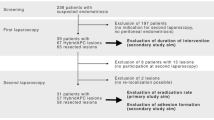Summary
Coagulation and vaporization of tissue are techniques applied in pelviscopic surgery in order to achieve hemostasis as well as cut and destroy endometriotic implants. An animal experimental study was devised to show if there is a difference in the incidence of adhesions after vaporization of equalsized areas of the anterior abdominal wall of the rat compared to coagulation of equal-sized areas. A similar depth of the lesions was achieved by repeting the vaporization procedure. The rate of adhesions was significantly lower (P<0.001, Chi2-test) post-coagulation, using a biopolar high frequency current or post-endocoagulation than post-vaporization. The surface vaporization of tissue, for example endometriotic implants, as produced by laser is to be viewed critically as regards the higher incidence of adhesions after vaporization compared with coagulation.
Similar content being viewed by others
References
Bellina JH (1983) Lasers in gynecology. World J Surg 7:692–699
Buckman RF, Woods M, Sargent L, Gervin AS (1976) A unifying pathogenetic mechanism in the etiology of intraperitoneal adhesions. J Surg Res 20:1–5
Buckman RF, Buckman D, Hufnagel HV, Gervin AS (1976) A physiological basis for the adhesionfree healing of deperitonealized surfaces. J Surg Res 21:67–76
Choe JK, Dawood MY, Bardawil WA, Andrews AH (1984) Clinical and histologic evaluating of laser reanastomosis of the uterine tube. Fertil Steril 41:754–760
Diamond MP, Daniell JF, Martin DC, Feste J, Vaughn WK, McLaughlin D (1984) Tubal patency and pelvic adhesions at early second-look laparoscopy following intraabdominal use of the carbon dioxide laser: initial report of the intraabdominal laser study group. Fertil Steril 42:717–723
Diamond MP, Feste J, Daniell JF, McLaughlin D, Martin DC (1984) Pelvic adhesions at early second-look laparoscopy following carbon dioxide laser surgical procedures. Infertility 7:39–44
Ellis H (1980) Internal overhealing: the problem of intraperitoneal adhesions World J Surg 4:303–306
Filmar S, Gomel V, McComb P (1986) The effectiveness of CO2 laser and electromicrosurgery in adhesiolysis: a comparative study. Fertil Steril 45:407–411
Gauwerky JFH, Kubli F (1986) Intraabdominelle Adhäsionen—Ursachen, Vorbeugung und Behandlung. Fertilität 2:125–143
Holtz G (1984) Prevention and management of peritoneal adhesions. Fertil Steril 41:497–507
Jackson BB (1958) Observations of intraperitoneal adhesions—an experimental study. Surgery 44:507–514
Kaplun A, Griffel B, Halperin B, Aronson M (1984) A model for adhesion formation by thermal injury in the abdominal cavity of the mouse. Eur Surg Res 16:131–135
Kaplun A, Aronson M, Halperin B, Griffel B (1984) Cellular events in adhesion formation due to thermal trauma. Eur Surg Res 16:136–140
Kelly RW, Roberts, DK (1983) CO2 laser laparoscopy. A potential alternative to Danazol in the treatment of stage I and II endometriosis. J Reprod Med 28:683–640
Lomano M (1985) Photocoagulation of early pelvic endometriosis with the Nd:YAG laser through the laparoscope. J Reprod Med 30:77–81
Luciano AA, Whitman G, Maier DB, Randolph J, Maenza R (1987) A comparison of thermal injury, healing pattern, and postoperative adhesion formation following CO2 laser and electromicrosurgery. Fertil Steril 48:1025–1929
Mecke H, Schünke M, Semm K, Schulz S. Histologische Untersuchungen zur Wundheilung und Peritonealisierung nach thermischer Schädigung von Gewebe. Lasermedizin. Laser Med, Surg
Mecke H, Schünke M, Freys I, Semm K (1989) The incidence of adhesions post-coagulation and post-vaporization of biological tissue: an animal experimental investigation. Laser Med Surg 5:165–170
Mecke H, Riedel H-H, Schloe U, Nekarda P (1989) Pelviskopische Verwachsungslösung mit Endokoagulation und Nd:YAG-Kontaktlaser—eine tierexperimentelle Studie. In: Frank F, Keiditsch E (eds) Verhandlungsbericht der Deutschen Gesellschaft für Lasermedizin. Erdmann Brenger, München-Zürich, pp 79–83
Nezhat C, Crowgey SR, Garrison CP (1986) Surgical treatment of endometriosis via laser laparoscopy. Fertil Steril 45:778–783
Pittaway DE, Maxon WS, Daniell JF (1983) A comparison of the CO2 laser and electrocautery on postoperative intraperitoneal adhesion formation in rabbits. Fertil Steril 40:336–368
Raftery AT (1979) Peritoneal fibrinolysis and adhesion formation. Br J Surg 66:358
Raftery AT (1981) Effect of peritoneal trauma on peritoneal fibrinolytic activity and intraperitoneal adhesion formation. Eur Surg Res 13:397–401
Semm K (1974) Transabdominale oder transvaginale Eileitersterilisation mit einer neuen Koagulationszange. Endocscopy 6:40–42
Semm K (1984) Operationslehre for endoskopische Abdominalchirurgie. Schattauer, Stuttgart New York. Translations: English-Year Book Medical Publishers, Chicago-London 1987; Japanese-Central Foreign Books, Tokyo, 1986; Italian—Martinucci Publicazioni Mediche, Neapel, 1987; Chinese—Shanghai Scientific and Technical Publishers (SSTP), 1987
Scheidel P, Wallweiner G (1982) Microsurgery adhesiolysis: a comparative study of the CO2 laser and the microelectrode in experimental animals. Eur J Obstet Gynecol Reprod Biol 14:55–61
Stangel JJ, Nisbet JD, Settles H (1984) Formation and prevention of postoperative abdominal adhesions. J Reprod Med 29:143–156
Trompke R, Siegner R (1956) Ein Beitrag zu den Verhütungsmaßnahmen postoperativer intraabdomineller Verwachsungen. Langenbecks Arch Chir 281:323–332
Wachstein M, Meisel E (1957) Histochemistry of hepatic phosphatases at a physiologic pH with special reference to the demonstration of bile caniculi. Am J Clin Pathol 27:13–23
Author information
Authors and Affiliations
Rights and permissions
About this article
Cite this article
Mecke, H., Schünke, M., Schulz, S. et al. Incidence of adhesions following thermal tissue damage. Res. Exp. Med. 191, 405–411 (1991). https://doi.org/10.1007/BF02576695
Received:
Accepted:
Issue Date:
DOI: https://doi.org/10.1007/BF02576695




